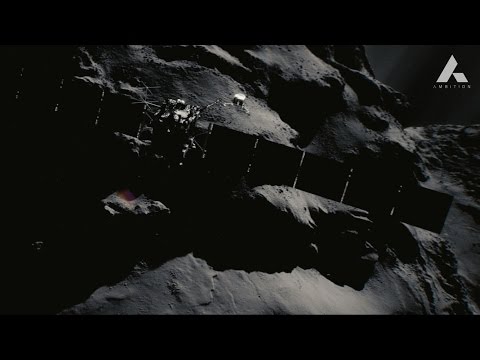This year I’ve been visiting a couple of conventions, for various reasons. First of all, my health has stabilized so much that I can hold a full-time employment that allows me this kind of luxury. Prior to that, my health problems caused me to live on a rather tight budget that didn’t easily allow for visiting conventions and exploring this aspect of geek lifestyle. Secondly, over the last years I have observed a lot of projects and communities that have failed – mostly due to a lack of engagement from their members and difficulties with recruiting active members. This doesn’t seem to be a critical issue for the big conventions I’ve attended, and I’m generally curious about what make certain groups of people endure where other groups fall apart. This inspired me to write the post
in which my conclusion is that particularly those groups succeed that pitch positive visions of society and social interactions. I could have been content with drawing that conclusion, but I am always eager to find out whether there is more to successful communities than that.
A rather particular reason for visiting FedCon was that I kinda promised to @zanthia to accompany her at the convention.
What is FedCon?
FedCon is one of the most prominent Star Trek conventions and has been going on for 26 consecutive years in the former German capital city of Bonn. After all those years the Star Trek fandom is still alive and vibrant, as is displayed by the many fan-made movies and series that are based on Star Trek. Over the recent years, it has turned into a more general sci-fi franchine convention that also attracts fans of Star Wars, Stargate, Battlestar Galactica, and most recently Guardians of the Galaxy:
Huge Rocket fan posing voluntarily
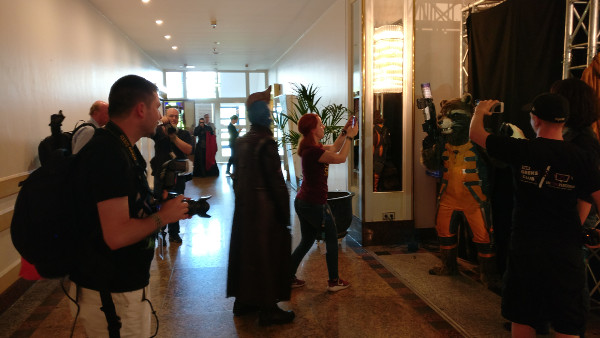
Huge Rocket fan fans posing involuntarily
My experiences
The location of the convention isn’t too close to the center of the city, so combining classical sightseeing with the convention wasn’t a really practical option. Since I wasn’t there for classical sightseeing that wasn’t any concern for me anyway.
My expectation was that I would be able to buy something that resembles the uniforms seen in the Star Trek series. Instead, they only had simple know-offs of the uniforms seen in the J.J. Abrams movies, which are more a parody of Star Trek than real Star Trek. At least there were Star Trek com badges for sale that weren’t too bad. Anyway, walking around in regular attire wasn’t really frowned upon on the convention.
Of course there were many kind of merchandise available, with some booths selling generic merchandise that you’d rather expect on ComicCon, and other less specific conventions. I’ve got a pretty neat Attack of Titan t-shirt by the way, and talked with the vendor about effective altruism, transhumanism, cryptocurrencies, and stuff. Well, that was a very unexpected highlight of the convention.
Panels
I’ve went to lots of different panels. There were panels on the philosophy of Star Trek, panels on the technology of Star Wars, and of course lots of Q&A panels with the stars of various shows, most prominently Matt Smith from Dr. Who, and most of the core cast of Star Trek: The Next Generation. There were also a couple of screenings of fan-made movies. Some of the most interesting panels were the science panels hosted by ESA members. I’ve got the impression that they truly lived the Star Trek spirit of exploring the universe when everyone else just dreams about doing that. It’s very fascinating how the ESA team members try to stay in touch with the Star Trek fandom, in particular because many of them are Trekkers themselves.
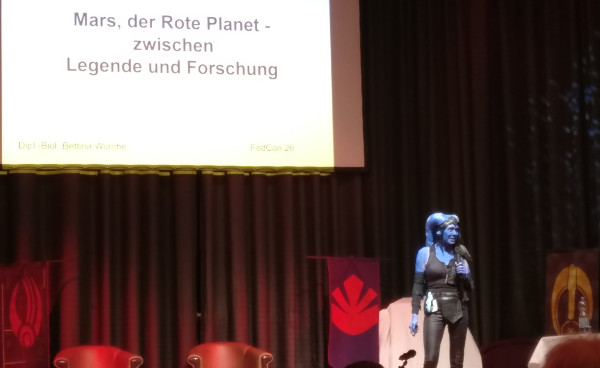
It’s quite impressive when panelists are cosplaying themselves, especially on that high level
ESA even had a small booth where they handed out information leaflets on their different space missions. It was particularly nice talking with the ESA members about topics like gravitational waves, aliens, science education, space garbage collection, and what they think about SpaceX (too reckless from their point of view). There was even a quiz where you had to answer science and sci-fi related questions and got the chance to win some ESA souvernirs
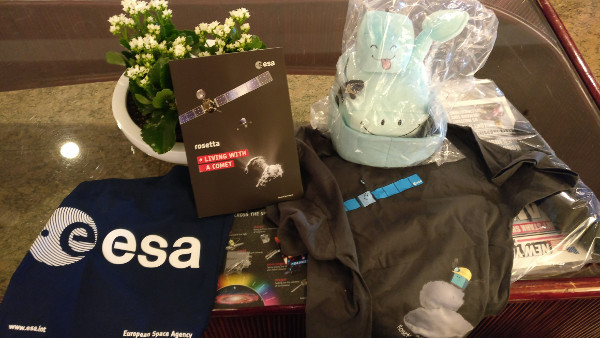
The science and luck were with me, and I won the stuff you’re seeing there, especially the Rosetta+Philiae plushie!
ESA is quite awesome in general. They are pretty cool people, and have even gifted us with the amazing short film Ambition about comets and the Rosetta mission in particular:
The stars
I’m not very starstruck, but it was really nice seeing the cast of Star Trek: The Next Generation in person. The biggest surprise for me is that Marina Sirtis is so different as person from her role as councelor Deanna Troi. On the panels, she was quite outspoken, and undiplomatic, quite unlike the soft and empathic character of Deanna Troi. It seemed to be a running gag that she’s so aggressive that the rest of the cast were kinda afraid of her outbursts.
For me, the most sympathetic actor was LeVar Burton playing Geordy La Forge. He seemed to be most convinced about the importance of science and becoming better persons – a vision that is very much exemplified in Star Trek: TNG.
The most annoying part of the convention was that Q&A panel with John de Lancie, with his role of “Q”, didn’t seem to be properly planned. They tried to fit the audience into the second largest room, which wasn’t nearly enough, and I’ve waited outside of the room in vain, because the queue wasn’t moving at all. Later on, they moved him into the largest room, but by then I was already busy with other things, so I missed out on that one.
On the last day of the convention there was a common panel with most of the cast. It was hilariously funny. I’ve really gotten the impression that the Star Trek: TNG cast became close friends in real life, and that this was a part of the magic of Star Trek: TNG.
The cosplayers
Cosplayers were of course present, but this year the cosplay contest seemed to have been as glorious as in previous years. It wasn’t even mostly about Star Trek cosplay, but about sci-fi characters in general, or even rather random ideas.
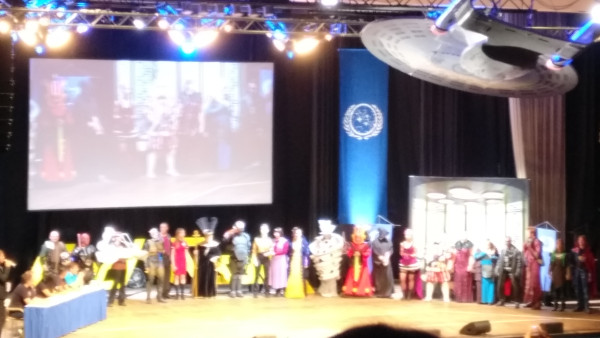
Don’t ask me what they are trying to represent, it was all a blur, especially from the back seats.
Interestingly, many of the more interesting cosplayers weren’t participating in the contest, and walking around on the convention area.
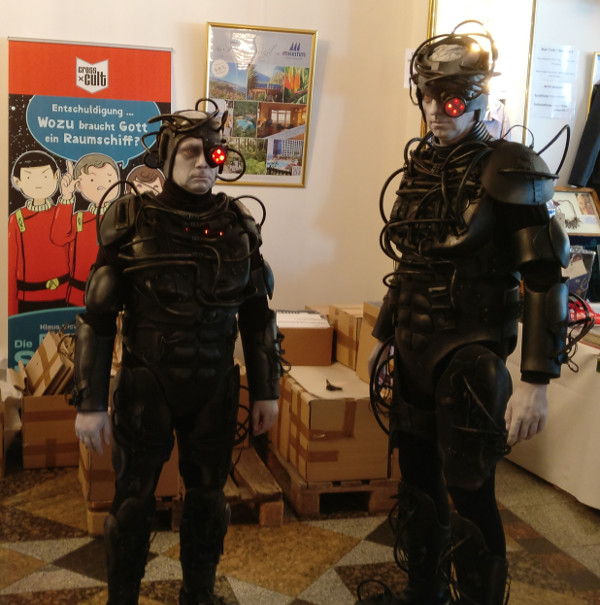
We are the Borg, we assimilate all your PC hardware and random cables to our bodies!
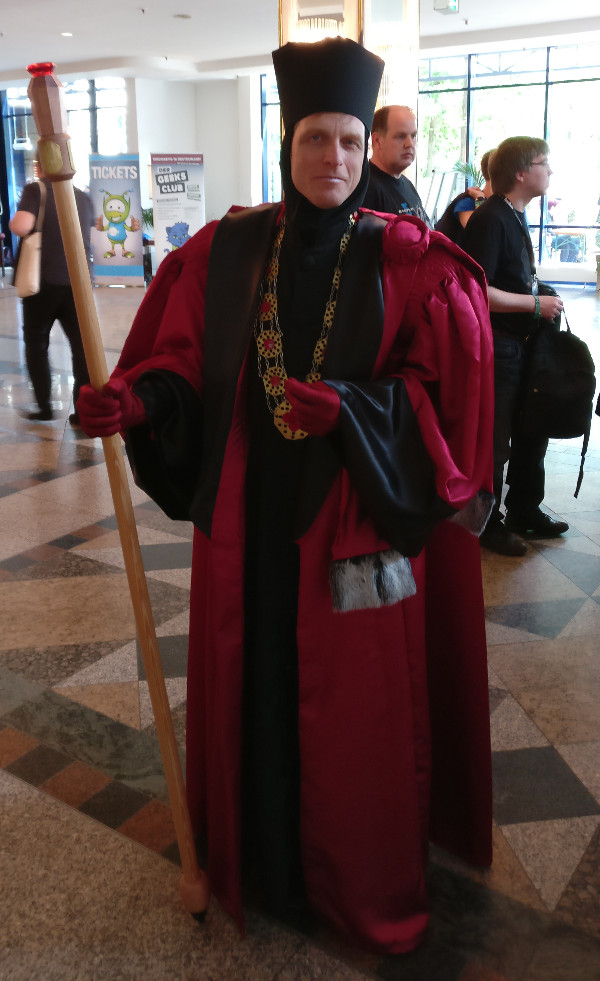
This friendly Q warned us about the dangers of exponentially multiplying tribble plushies – thank Q very much!
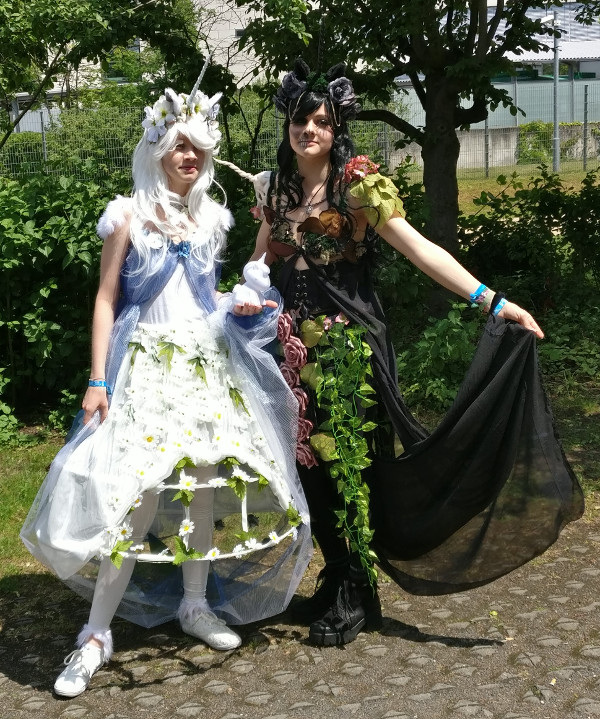
Always be yourself, but if you can be a couple of complementary unicorns, be that instead! How does this fit into a sci-fi convention? Genetic engineering, I guess. Not everything does have to make sense, though. It suffices, if it looks visually impressive.
Sidenotes
- Beer and cocktails were also available, especially after all the panels were over. Neat.
- Trekkers don’t seem to be very likely to read true hard sci-fi books. What a shame!
- There are people who write books inspired by Star Trek, but I found them to be rather uninspiring
- David Hasselhoff (because Knight Rider) was there, but also kinda awkward.
- I got a nice small claymore replica as paper knife, but it turned out to be so dull that my efforts at sharpening it were futile
Conclusion
It’s hard to judge the spirit of the Star Trek fandom by going to a Star Trek convention. From the outside it doesn’t look too different from any other fandom. The true spirit of Star Trek lives on on the TV productions. Bringing that spirit into the real world is an almost impossible task. Those who come closest to that are the people from ESA. They embody an aspect of the best of humanity. Also, friendship creates magic.

